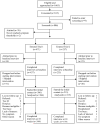The utility of screening in the design of trials for symptom management in cancer
- PMID: 19699052
- PMCID: PMC2761530
- DOI: 10.1016/j.jpainsymman.2009.02.233
The utility of screening in the design of trials for symptom management in cancer
Abstract
Clinical trials that test interventions for symptom management must target patients whose symptoms are severe and can benefit from participation. Screening symptoms for their severity prior to trial entry may be an important element of trial design. This research describes the utility of screening for severity of symptoms prior to entry into clinical trials for symptom management in cancer. To accomplish this, 601 cancer patients undergoing chemotherapy were assessed at screening and at the initial intervention contact, using the 0-10 rating scale for severity of nine symptoms. Post-test probabilities and likelihood ratios (LRs) were estimated across cut-offs in screening severity scores. Areas under receiver operating characteristic curves for reaching threshold of four at the initial intervention contact were estimated by a nonparametric method. It was found that screening severity scores were good predictors for identifying patients who would not reach threshold but did not always accurately predict patients who would. The cut-offs between 2 and 4 on a 0-10 scale could be used to identify patients that might benefit from receipt of interventions. For all symptoms, the LRs were greater than one across possible screening cut-offs. The findings indicate that decision rules based on screening prior to entry into cancer symptom management trials can provide reasonable discriminative accuracy by differentiating among patients who are likely to reach higher levels of severity later in the trial from those who are not. Optimal severity cut-offs can be established based on LRs and desired sensitivity and specificity.
Figures


Similar articles
-
Folic acid supplementation and malaria susceptibility and severity among people taking antifolate antimalarial drugs in endemic areas.Cochrane Database Syst Rev. 2022 Feb 1;2(2022):CD014217. doi: 10.1002/14651858.CD014217. Cochrane Database Syst Rev. 2022. PMID: 36321557 Free PMC article.
-
Screening for Eating Disorders in Adolescents and Adults: An Evidence Review for the U.S. Preventive Services Task Force [Internet].Rockville (MD): Agency for Healthcare Research and Quality (US); 2022 Mar. Report No.: 21-05284-EF-1. Rockville (MD): Agency for Healthcare Research and Quality (US); 2022 Mar. Report No.: 21-05284-EF-1. PMID: 35344311 Free Books & Documents. Review.
-
Severely Burdened Individuals Do Not Need to Be Excluded From Internet-Based and Mobile-Based Stress Management: Effect Modifiers of Treatment Outcomes From Three Randomized Controlled Trials.J Med Internet Res. 2018 Jun 19;20(6):e211. doi: 10.2196/jmir.9387. J Med Internet Res. 2018. PMID: 29921562 Free PMC article. Clinical Trial.
-
Do interference-based cut-points differentiate mild, moderate, and severe levels of 16 cancer-related symptoms over time?J Pain Symptom Manage. 2009 Feb;37(2):220-32. doi: 10.1016/j.jpainsymman.2008.01.010. Epub 2008 Jul 10. J Pain Symptom Manage. 2009. PMID: 18619769 Free PMC article. Review.
-
Vesicoureteral Reflux.2024 Apr 30. In: StatPearls [Internet]. Treasure Island (FL): StatPearls Publishing; 2025 Jan–. 2024 Apr 30. In: StatPearls [Internet]. Treasure Island (FL): StatPearls Publishing; 2025 Jan–. PMID: 33085409 Free Books & Documents.
Cited by
-
Testing the differential effects of symptom management interventions in cancer.Psychooncology. 2015 Jan;24(1):25-32. doi: 10.1002/pon.3555. Epub 2014 Apr 15. Psychooncology. 2015. PMID: 24737669 Free PMC article. Clinical Trial.
-
Cognitive behavioral symptom management intervention in patients with cancer: survival analysis.Support Care Cancer. 2012 Jun;20(6):1243-50. doi: 10.1007/s00520-011-1210-0. Epub 2011 Jun 11. Support Care Cancer. 2012. PMID: 21667048 Clinical Trial.
-
Symptom Care at Home: A Comprehensive and Pragmatic PRO System Approach to Improve Cancer Symptom Care.Med Care. 2019 May;57 Suppl 5 Suppl 1(Suppl 5 1):S66-S72. doi: 10.1097/MLR.0000000000001037. Med Care. 2019. PMID: 30531525 Free PMC article.
-
Self-reported physical symptoms in intensive care unit (ICU) survivors: pilot exploration over four months post-ICU discharge.J Pain Symptom Manage. 2014 Feb;47(2):257-70. doi: 10.1016/j.jpainsymman.2013.03.019. Epub 2013 Jul 12. J Pain Symptom Manage. 2014. PMID: 23856099 Free PMC article.
-
Using SMART design to improve symptom management among cancer patients: A study protocol.Res Nurs Health. 2017 Dec;40(6):501-511. doi: 10.1002/nur.21836. Epub 2017 Nov 11. Res Nurs Health. 2017. PMID: 29130496 Free PMC article. Clinical Trial.
References
-
- National Comprehensive Cancer Network Clinical practice guidelines in oncology: cancer-related fatigue. 2006. Available from: http://www.nccn.org/professionals/physician_gls/PDF/fatigue.pdf. Accessed June 28, 2006. - PubMed
-
- Kroneke K. Studying symptoms: sampling and measurement issues. Ann Intern Med. 2001;134:844–853. - PubMed
-
- Komaroff AL. Symptoms: in the head or in the brain? Ann Intern Med. 2001;134:783–785. - PubMed
-
- Koller M, Heitmann K, Kussmann J, Lorenz W. Symptom reporting in cancer patients II: relations to social desirability, negative affect, and self-reported health behaviors. Cancer. 1999;86:1609–1620. - PubMed
-
- Given CW, Given B, Azzouz F, Kozachik S, Stommel M. Predictors of pain and fatigue in the year following diagnosis among elderly cancer patients. J Pain Symptom Manage. 2001;21:456–466. - PubMed
Publication types
MeSH terms
Grants and funding
LinkOut - more resources
Full Text Sources

